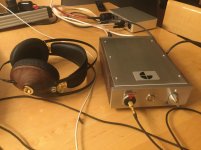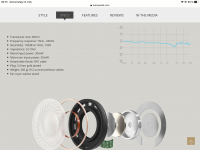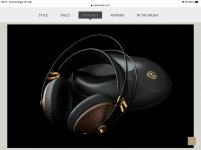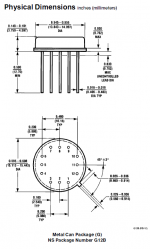Azul headphone amp (BAF 2019) uses an OPA1611 + LH0033 composite. It'll deliver 75mA RMS into a 32 ohm load; that is 180 mW which is quite a bit greater than the rated maximum shown in post #162.
But after (sighted) opamp rolling, I discovered I prefer the sonics with LT1122 + LH0033. The late, great George Erdi knew what he was doing when he designed the LT1122.
_
But after (sighted) opamp rolling, I discovered I prefer the sonics with LT1122 + LH0033. The late, great George Erdi knew what he was doing when he designed the LT1122.
_
Attachments
Azul headphone amp (BAF 2019) uses an OPA1611 + LH0033 composite. It'll deliver 75mA RMS into a 32 ohm load; that is 180 mW which is quite a bit greater than the rated maximum shown in post #162.
But after (sighted) opamp rolling, I discovered I prefer the sonics with LT1122 + LH0033. The late, great George Erdi knew what he was doing when he designed the LT1122.
_
I'm not sure what redeeming qualities the LT1122 has these days, from an objective standpoint. It's not particularly fast and it's noisy. It seems like it's blown away in every metric by OPA810 and OPA828.
I build a headphone amplifier prototype with it without buffer. I have not measured it so far.
I love that case. I'm a huge pan of walnut (or other types of wood) side panels.
I'm not sure what redeeming qualities the LT1122 has these days, from an objective standpoint.
Given its age, its cheap on the secondary market. Around $0.30 a pop. AD744 is cheaper still though and at half the supply current.
I mean, even -60dB of any distortion should not be audible but why sound components different? Are we measuring the wrong thing ? Can sound quality be quantified per se ?
Of course that THD is not so important to the human ear/brain tandem : the last step in the signal reproduction chain is the loudspeaker itself showing more than several percent of THD in the best case ! So how would you be able to distinguish 0.0001% from 0.1% of THD in an amplifier feeding a loudspeaker ? As a comparison, we are much more sensible to IMD and even much more to phase distortion leading to jitter in digital domain (timing errors) and to group delay disorder in analog domain. In fact, we should always consider the time domain for dynamic signals (like music) and not only the harmonic domain for static measurement signals...
Back to the main OPA1656 thread...
Is there any Spice model to simulate the channel cross talk of this dual OP-AMP?
Do you (TI) plan to provide any metal TO-99 case too?
Hp
Is there any Spice model to simulate the channel cross talk of this dual OP-AMP?
Single OPA1655: They're working on it! Stay tuned.
Do you (TI) plan to provide any metal TO-99 case too?
Hp
Back to the main OPA1656 thread...
Is there any Spice model to simulate the channel cross talk of this dual OP-AMP?
Do you (TI) plan to provide any metal TO-99 case too?
Hp
Spice models almost never include crosstalk and most often the model for the single/dual/quad versions of an op amp are the same unless there is a significant parametric difference between the variants. You could probably duplicate the effects with a passive component network outside of the op amp macromodel.
At audio frequencies I normally see the internal crosstalk of an op amp totally swamped by power supply effects or the impedance of the ground plane on the PCB. On headphone amplifiers its always the shared ground contact in the headphone jack which usually limits crosstalk between the left and right channels to about -70dB. The good thing is that you don't listen to speakers at home with a wall running down the center of your room right up to your face...
It's not really my call, but I can say with almost absolute certainty that there will not be a TO-99 package of this device. The economics of that would not make any sense. The only way I could see that happening is if an outside company wanted to make that product, we'd love to sell them bare die and let them do the packaging.
Maybe your minimum order qty for bare die is small. Possibly small enough that member HpW could buy some for his own use, have them packaged in TO-99 or other package of his choice, and sell off any extras he doesn't need. I'm sure the rarity and general unavailability would be beneficial selling points with other audiophiles.
Although I myself favor the 12 lead "G" package: it's big, brawny, and brutal. Topside flat plane is big enough to attach a substantial heatsink, and the package tab gives you the ability to connect the can to quiet-ground if you wish.
_
Although I myself favor the 12 lead "G" package: it's big, brawny, and brutal. Topside flat plane is big enough to attach a substantial heatsink, and the package tab gives you the ability to connect the can to quiet-ground if you wish.
_
Attachments
Spice models almost never include crosstalk and most often the model for the single/dual/quad versions of an op amp are the same unless there is a significant parametric difference between the variants. You could probably duplicate the effects with a passive component network outside of the op amp macromodel.
At the data sheet figure 13 about the channel separation:
May you provide the full circuit of the used measurements fig 13 ?
The spec's say -135dB's and the figure f(freq) tells/shows more details.
Hp
On the bright side, our precision DAC team has released our new flagship 20-bit R2R DAC, the DAC11001A. I am excited to see if anyone wants to try to use it for audio
I am working on an audio reference design using the DAC11001A that I hope to release on the web in the next few months. It is a bit of a science project, but I am seeing nice audio performance and I am using John's opa1656 as the primary output buffer.
Just curious, why do you think this DAC has any place in the audio realm? Based on the data sheet it looks respectable (although not great) as a 20bit DAC, but for audio purposes there are the same or better chips, even from TI. Which would at least avoid the usual complication of converting SPI to I2S, that requires some hairy logic or a small fast FPGA.
Just curious, why do you think this DAC has any place in the audio realm? Based on the data sheet it looks respectable (although not great) as a 20bit DAC, but for audio purposes there are the same or better chips, even from TI. Which would at least avoid the usual complication of converting SPI to I2S, that requires some hairy logic or a small fast FPGA.
I created a new thread for the DAC11001A so we don't derail the OPA1656 too much
https://www.diyaudio.com/forums/vendor-s-bazaar/349809-dac11001-20-bit-2r-precision-dac.html#post6087981
Is there any explanation for opa1656 resulting in much higher distortion harmonics than opa1612 in i/v? Is opa1656 too slow for that? Or is there something else to optimize to? Thanks.
That would be a major surprise to me. You might want to post your circuit on e2e.ti.com to get assistance with it.
My first thought, assuming you're not violating the datasheet in some way, is to make sure you cleaned the PCB after swamping amplifiers (or the adapter board if you are plugging into a dip socket). Flux between the input pins of an op amp is great for generating tons of distortion.
Hi John
I am also looking at IV conversion with output at 1Vrms
From the datasheet of OPA1656 or OPA2156, it seems that at 1Vrms THD+N , OPA1656 performs better .
However I like the slew rate of OPA2156 , any pointers on what to improve THD+N ? I am thinking of a composite amplifier so the load and feedback will be driven by the second opamp..
I am also looking at IV conversion with output at 1Vrms
From the datasheet of OPA1656 or OPA2156, it seems that at 1Vrms THD+N , OPA1656 performs better .
However I like the slew rate of OPA2156 , any pointers on what to improve THD+N ? I am thinking of a composite amplifier so the load and feedback will be driven by the second opamp..
I HIGHLY doubt that the difference between 24V/µSec and 40V/µSec is audible.However I like the slew rate of OPA2156
- Home
- Vendor's Bazaar
- OPA1656: High-Performance CMOS Audio Op Amp



